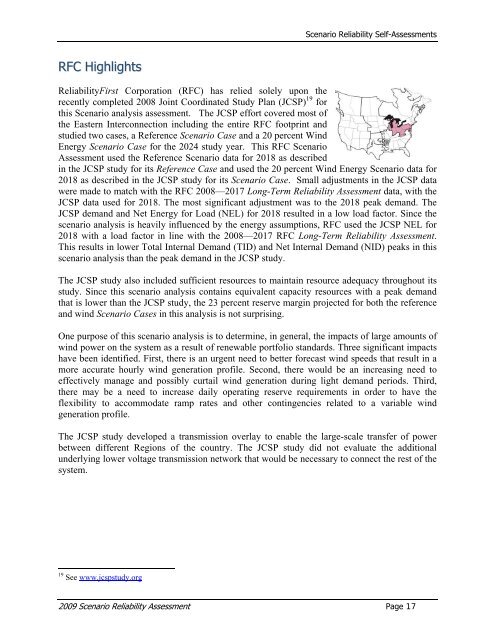2009 Scenario Reliability Assessment - NERC
2009 Scenario Reliability Assessment - NERC
2009 Scenario Reliability Assessment - NERC
- No tags were found...
Create successful ePaper yourself
Turn your PDF publications into a flip-book with our unique Google optimized e-Paper software.
<strong>Scenario</strong> <strong>Reliability</strong> Self-<strong>Assessment</strong>sRFC Highlights<strong>Reliability</strong>First Corporation (RFC) has relied solely upon therecently completed 2008 Joint Coordinated Study Plan (JCSP) 19 forthis <strong>Scenario</strong> analysis assessment. The JCSP effort covered most ofthe Eastern Interconnection including the entire RFC footprint andstudied two cases, a Reference <strong>Scenario</strong> Case and a 20 percent WindEnergy <strong>Scenario</strong> Case for the 2024 study year. This RFC <strong>Scenario</strong><strong>Assessment</strong> used the Reference <strong>Scenario</strong> data for 2018 as describedin the JCSP study for its Reference Case and used the 20 percent Wind Energy <strong>Scenario</strong> data for2018 as described in the JCSP study for its <strong>Scenario</strong> Case. Small adjustments in the JCSP datawere made to match with the RFC 2008—2017 Long-Term <strong>Reliability</strong> <strong>Assessment</strong> data, with theJCSP data used for 2018. The most significant adjustment was to the 2018 peak demand. TheJCSP demand and Net Energy for Load (NEL) for 2018 resulted in a low load factor. Since thescenario analysis is heavily influenced by the energy assumptions, RFC used the JCSP NEL for2018 with a load factor in line with the 2008—2017 RFC Long-Term <strong>Reliability</strong> <strong>Assessment</strong>.This results in lower Total Internal Demand (TID) and Net Internal Demand (NID) peaks in thisscenario analysis than the peak demand in the JCSP study.The JCSP study also included sufficient resources to maintain resource adequacy throughout itsstudy. Since this scenario analysis contains equivalent capacity resources with a peak demandthat is lower than the JCSP study, the 23 percent reserve margin projected for both the referenceand wind <strong>Scenario</strong> Cases in this analysis is not surprising.One purpose of this scenario analysis is to determine, in general, the impacts of large amounts ofwind power on the system as a result of renewable portfolio standards. Three significant impactshave been identified. First, there is an urgent need to better forecast wind speeds that result in amore accurate hourly wind generation profile. Second, there would be an increasing need toeffectively manage and possibly curtail wind generation during light demand periods. Third,there may be a need to increase daily operating reserve requirements in order to have theflexibility to accommodate ramp rates and other contingencies related to a variable windgeneration profile.The JCSP study developed a transmission overlay to enable the large-scale transfer of powerbetween different Regions of the country. The JCSP study did not evaluate the additionalunderlying lower voltage transmission network that would be necessary to connect the rest of thesystem.19 See www.jcspstudy.org<strong>2009</strong> <strong>Scenario</strong> <strong>Reliability</strong> <strong>Assessment</strong> Page 17
















